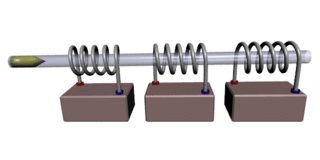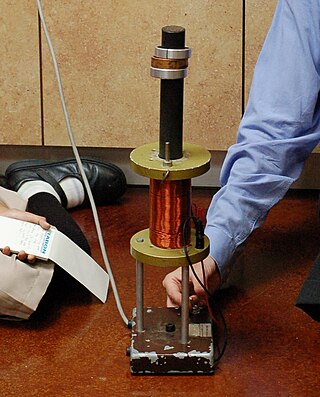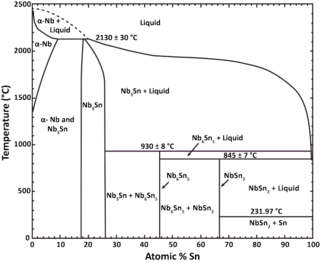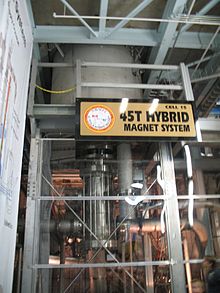Superconducting magnetic energy storage (SMES) systems store energy in the magnetic field created by the flow of direct current in a superconducting coil which has been cryogenically cooled to a temperature below its superconducting critical temperature. This use of superconducting coils to store magnetic energy was invented by M. Ferrier in 1970.

A magnetic field is a physical field that describes the magnetic influence on moving electric charges, electric currents, and magnetic materials. A moving charge in a magnetic field experiences a force perpendicular to its own velocity and to the magnetic field. A permanent magnet's magnetic field pulls on ferromagnetic materials such as iron, and attracts or repels other magnets. In addition, a nonuniform magnetic field exerts minuscule forces on "nonmagnetic" materials by three other magnetic effects: paramagnetism, diamagnetism, and antiferromagnetism, although these forces are usually so small they can only be detected by laboratory equipment. Magnetic fields surround magnetized materials, electric currents, and electric fields varying in time. Since both strength and direction of a magnetic field may vary with location, it is described mathematically by a function assigning a vector to each point of space, called a vector field.

A magnet is a material or object that produces a magnetic field. This magnetic field is invisible but is responsible for the most notable property of a magnet: a force that pulls on other ferromagnetic materials, such as iron, steel, nickel, cobalt, etc. and attracts or repels other magnets.

An electric motor is an electrical machine that converts electrical energy into mechanical energy. Most electric motors operate through the interaction between the motor's magnetic field and electric current in a wire winding to generate force in the form of torque applied on the motor's shaft. An electric generator is mechanically identical to an electric motor, but operates in reverse, converting mechanical energy into electrical energy.

An electromagnet is a type of magnet in which the magnetic field is produced by an electric current. Electromagnets usually consist of wire wound into a coil. A current through the wire creates a magnetic field which is concentrated in the hole in the center of the coil. The magnetic field disappears when the current is turned off. The wire turns are often wound around a magnetic core made from a ferromagnetic or ferrimagnetic material such as iron; the magnetic core concentrates the magnetic flux and makes a more powerful magnet.

A solenoid is a type of electromagnet formed by a helical coil of wire whose length is substantially greater than its diameter, which generates a controlled magnetic field. The coil can produce a uniform magnetic field in a volume of space when an electric current is passed through it.
An explosively pumped flux compression generator (EPFCG) is a device used to generate a high-power electromagnetic pulse by compressing magnetic flux using high explosive.

A coilgun is a type of mass driver consisting of one or more coils used as electromagnets in the configuration of a linear motor that accelerate a ferromagnetic or conducting projectile to high velocity. In almost all coilgun configurations, the coils and the gun barrel are arranged on a common axis. A coilgun is not a rifle as the barrel is smoothbore.

A superconducting magnet is an electromagnet made from coils of superconducting wire. They must be cooled to cryogenic temperatures during operation. In its superconducting state the wire has no electrical resistance and therefore can conduct much larger electric currents than ordinary wire, creating intense magnetic fields. Superconducting magnets can produce stronger magnetic fields than all but the strongest non-superconducting electromagnets, and large superconducting magnets can be cheaper to operate because no energy is dissipated as heat in the windings. They are used in MRI instruments in hospitals, and in scientific equipment such as NMR spectrometers, mass spectrometers, fusion reactors and particle accelerators. They are also used for levitation, guidance and propulsion in a magnetic levitation (maglev) railway system being constructed in Japan.

Electrodynamic suspension (EDS) is a form of magnetic levitation in which there are conductors which are exposed to time-varying magnetic fields. This induces eddy currents in the conductors that creates a repulsive magnetic field which holds the two objects apart.
Francis Bitter was an American physicist.

The Levitated Dipole Experiment (LDX) was an experiment investigating the generation of fusion power using the concept of a levitated dipole. The device was the first of its kind to test the levitated dipole concept and was funded by the US Department of Energy. The machine was also part of a collaboration between the MIT Plasma Science and Fusion Center and Columbia University, where another (non-levitated) dipole experiment, the Collisionless Terrella Experiment (CTX), was located.
The tesla is the unit of magnetic flux density in the International System of Units (SI).

The National High Magnetic Field Laboratory (MagLab) is a facility at Florida State University, the University of Florida, and Los Alamos National Laboratory in New Mexico, that performs magnetic field research in physics, biology, bioengineering, chemistry, geochemistry, biochemistry. It is the only such facility in the US, and is among twelve high magnetic facilities worldwide. The lab is supported by the National Science Foundation and the state of Florida, and works in collaboration with private industry.

Niobium–tin is an intermetallic compound of niobium (Nb) and tin (Sn), used industrially as a type-II superconductor. This intermetallic compound has a simple structure: A3B. It is more expensive than niobium–titanium (NbTi), but remains superconducting up to a magnetic flux density of 30 teslas [T] (300,000 G), compared to a limit of roughly 15 T for NbTi.
Niobium–titanium (Nb-Ti) is an alloy of niobium and titanium, used industrially as a type II superconductor wire for superconducting magnets, normally as Nb-Ti fibres in an aluminium or copper matrix.
This page lists examples of magnetic induction B in teslas and gauss produced by various sources, grouped by orders of magnitude.
Flux pumping is a method for magnetising superconductors to fields in excess of 15 teslas. The method can be applied to any type II superconductor and exploits a fundamental property of superconductors, namely their ability to support and maintain currents on the length scale of the superconductor. Conventional magnetic materials are magnetised on a molecular scale which means that superconductors can maintain a flux density orders of magnitude bigger than conventional materials. Flux pumping is especially significant when one bears in mind that all other methods of magnetising superconductors require application of a magnetic flux density at least as high as the final required field. This is not true of flux pumping.
A Split Magnet is a resistive electromagnet that is separated into two halves, with the small gap that divides the two sides allowing access to a strong magnetic field. The combination of an accessible gap and strong magnetic field allows for the research of how far-infrared particles scatter. In addition, the magnet can also rotate up to 90°, allowing for the magnet to become parallel to the floor. The magnet uses a combination of 28 MW, a current of 160,000 amps and 13380 liters of water per minute used. The strongest split helix magnet in the world is currently located in Florida State University at the National High Magnetic Field Laboratory, and can generate a field of 25 Tesla.

Magnetic levitation (maglev) or magnetic suspension is a method by which an object is suspended with no support other than magnetic fields. Magnetic force is used to counteract the effects of the gravitational force and any other forces.














